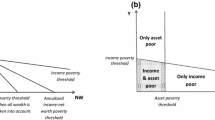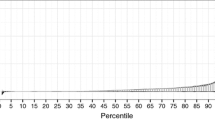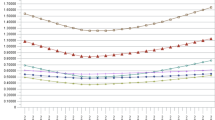Abstract
Using data from India, we estimate the relationship between household wealth and children’s school enrollment. We proxy wealth by constructing a linear index from asset ownership indicators, using principal-components analysis to derive weights. In Indian data this index is robust to the assets included, and produces internally coherent results. State-level results correspond well to independent data on per capita output and poverty. To validate the method and to show that the asset index predicts enrollments as accurately as expenditures, or more so, we use data sets from Indonesia, Pakistan, and Nepal that contain information on both expenditures and assets. The results show large, variable wealth gaps in children’s enrollment across Indian states. On average a “rich” child is 31 percentage points more likely to be enrolled than a “poor” child, but this gap varies from only 4.6 percentage points in Kerala to 38.2 in Uttar Pradesh and 42.6 in Bihar.
Similar content being viewed by others
References
Agrawal, A.N., H.O. Varma, and R.C. Gupta. 1996. India Economic Information Year-Book. New Delhi: National.
Ashenfelter, O. and A. Krueger. 1994. “Estimates of the Economic Returns to Schooling From a New Sample of Twins.” American Economic Review 84:1157–73.
Behrman, J.R. and J.C. Knowles. 1999. “Household Income and Child Schooling in Vietnam.” World Bank Economic Review 13(2):211–56.
Bonilla-Chacin, M. and J.S. Hammer. 1999. “Life and Death Among the Poorest.” Johns Hopkins University and Development Economics Research Group, World Bank, Washington, DC. Photocopied document.
Deaton, A. 1997. The Analysis of Household Surveys. Washington, DC: Johns Hopkins University Press.
Deaton, A. and J. Muellbauer. 1980. Economics and Consumer Behavior. Cambridge, UK: Cambridge University Press.
Deaton, A. and S. Zaidi. 1999. “Guidelines for Constructing Consumption Aggregates for Welfare Analysis.” Working Paper 192, Princeton University Research Program in Development Studies, Princeton, NJ.
Dreze, J. and P.V. Srinivasan. 1997. “Widowhood and Poverty in Rural India: Some Inferences From Household Survey Data.” Journal of Development Economics 54:217–34.
Fields, G.S. 1998. “Income Mobility: Meaning, Measurement, and Some Evidence for the Developing World.” Department of Industrial and Labor Relations, Cornell University. Photocopied document.
Filmer, D. 2000. “The Structure of Social Disparities in Education: Gender and Wealth.” World Bank Policy Research Working Paper 2268, Development Economics Research Group, World Bank, Washington, DC.
Filmer, D. and L. Pritchett. 1998. “Estimating Wealth Effects Without Expenditure Data—Or Tears: With an Application to Educational Enrollments in States of India.” World Bank Policy Research Working Paper 1994, Development Economics Research Group, World Bank, Washington, DC.
—. 1999a. “The Effect of Household Wealth on Educational Attainment: Evidence From 35 Countries.” Population and Development Review 25(1):85–120.
—. 1999b. “Determinants of Education Enrollment in India: Child, Household, Village and State Effects.” Journal of Educational Planning and Administration 13(2):135–64.
Grosh, M. and P. Glewwe. 1998. “The World Bank’s Living Standards Measurement Study Household Surveys.” Journal of Economic Perspectives 12:187–96.
Gwatkin, D.R., S. Rutstein, K. Johnson, R. Pande, and A. Wagstaff. 2000. “Socio-Economic Differences in Health, Nutrition, and Population.” HNP/Poverty Thematic Group, World Bank, Washington, DC.
Haque, T., P. Lanjouw, and M. Ravallion. 1998. “A Poverty Profile for India 1993-94.” Development Research Group, The World Bank, Washington, DC. Photocopied document.
Jalan, J. and M. Ravallion. 1998. “Transient Poverty in Postreform Rural China.” Journal of Comparative Economics 26:338–57.
—. 1995. “Poverty and Household Size.” Economic Journal 105(433):1415–34.
Lindeman, R.H., P.F. Merenda, and R.Z. Gold. 1980. Introduction to Bivariate and Multivariate Analysis. New York: Scott, Foresman.
Maddala, G.S. 1988. Introduction to Econometrics. New York: Macmillan.
Montgomery, M.R., M. Gragnolati, K.A. Burke, and E. Paredes. 2000. “Measuring Living Standards With Proxy Variables.” Demography 27:155–74.
National Council of Applied Economic Research (NCAER). 1994. “Non-Enrollment, Drop-Out, and Private Expenditures on Elementary Education: A Comparison Across States and Population Groups.” New Delhi. Photocopied document.
Patrinos, H.A. 1997. “Differences in Education and Earnings Across Ethnic Groups in Guatemala.” Quarterly Review of Economics and Finance 37:809–21.
Sahn, D. and D.C. Stifel. 1999. “Poverty Comparisons Over Time and Across Countries in Africa.” Cornell Food and Nutrition Policy Program, Cornell University. Photocopied document.
Skoufias, E. 1999. “Krismon and Its Impact on Household Welfare: Preliminary Evidence From Household Panel Data From the 100 Village Survey in Indonesia.” International Food Policy Research Institute, Washington, DC. Photocopied document
StataCorp. 1999. Stata Statistical Software: Release 6.0. College Station, TX: Stata Corporation.
Stecklov, G., A. Bommier, and T. Boerma. 1999. “Trends in Equity in Child Survival in Developing Countries: A Illustrative Example Using Ugandan Data.” MEASURE Evaluation Project/ Carolina Population Center, INED, Chapel Hill, NC. Photocopied document.
World Bank. 1998. “Reducing Poverty in India: Options for More Effective Public Services.” Report 17881-IN, The World Bank, Washington, DC.
Author information
Authors and Affiliations
Additional information
This research was funded in part through World Bank research support grant (RPO 682-11). We would like to thank Harold Alderman, Zoubida Allaoua, Gunnar Eskeland, Jeffrey Hammer, Keith Hinchliffe, Valerie Kozel, Alan Krueger, Peter Lanjouw, Marlaine Lockheed, Berk Ozler, and Martin Ravallion for valuable discussions and comments, including some on an earlier version of this paper (Filmer and Pritchett 1998). The findings, interpretations, and conclusions expressed here are entirely those of the authors. They do not necessarily represent the views of the World Bank, its executive directors, or the countries they represent.
Rights and permissions
About this article
Cite this article
Filmer, D., Pritchett, L.H. Estimating Wealth Effects Without Expenditure Data—Or Tears: An Application To Educational Enrollments In States Of India*. Demography 38, 115–132 (2001). https://doi.org/10.1353/dem.2001.0003
Issue Date:
DOI: https://doi.org/10.1353/dem.2001.0003




